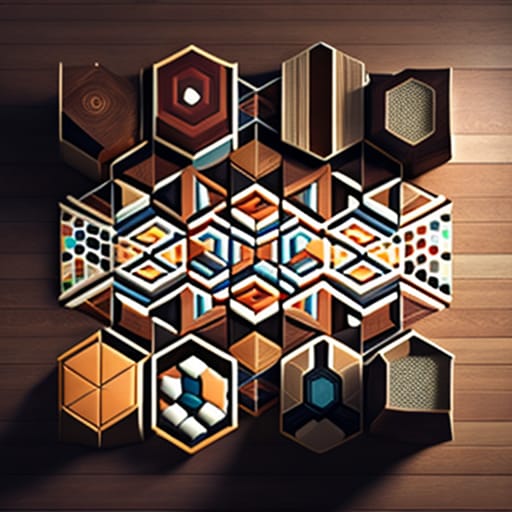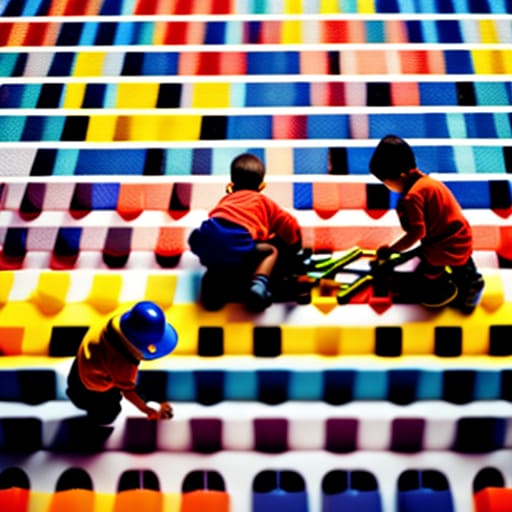Wooden blocks have been a staple of early childhood classrooms for over a century. While new toys and technologies emerge every year claiming to be the best for preschool education, simple wooden blocks continue to offer immense value in shaping young children’s learning and development.
The Timeless Benefits of Wooden Blocks
Wooden blocks support nearly all key developmental domains in the early years:
- Cognitive skills: Block play builds skills like spatial reasoning, problem-solving, organization, STEM concepts
- Math concepts: Children explore ideas like weight, shape, symmetry, counting, patterns
- Language development: Block structures spark storytelling and grow descriptive vocabulary
- Physical abilities: Develops fine motor control, coordination through building
- Social-emotional skills: Fosters sharing, cooperation, empathy and self-confidence
Unlike flashy electronic toys, wooden blocks uniquely cross domains to nurture creativity, critical thinking and foundational skills needed for academic and lifelong success.
Laying the Building Blocks of Learning
The simple act of stacking, arranging and manipulating wooden blocks builds key connections in young children’s brains during critical windows of opportunity.
Language and Literacy
Preschoolers use an average of over 100 descriptive words during prolonged block play sessions. As children discuss ideas, negotiate roles and describe their structures, block play provides a rich environment for vocabulary building. Studies show block play also helps children later grasp concepts regarding print and develop early writing skills.
Mathematical Understanding
Playing with wooden blocks has been linked with improved performance in math, especially in areas like measurement, geometry and spatial visualization. As children stack, line up and knock down blocks, they sharpen their capacity to recognize shapes, understand concepts like balance and symmetry and make comparisons between objects—key math readiness skills.
Table1. Key Math Concepts Learned through Block Play
| Math Concept | Description |
|---|---|
| Patterning | Creating and extending repeating patterns with blocks builds algebraic thinking |
| Spatial Relationships | Language comparing block structures develops understanding of position words like “under,” “between,” “next to” |
| Geometry | Handling and observing various block shapes teaches properties like angles, faces, curves |
| Measurement | Comparing block sizes and weights supports benchmarking abilities |
| Part-Whole Relations | Taking apart and reassembling structures develops concept of part vs whole |
21st Century Skills
Open-ended block play fosters many of the critical expertise needed for the 21st century workplace, including creative problem-solving, critical thinking, communication skills and the ability to synthesize information.
Unlike structured activities with defined outcomes, blocks offer endless possibilities. Guiding their own experience boosts self-confidence, curiosity, flexibility and resourcefulness. The visual-spatial nature of manipulating blocks also helps strengthen spatial reasoning and visualization abilities linked with success in engineering and tech fields.
Designing High-Impact Block Play Experiences
While wooden blocks offer tremendous potential for learning, the environment and approach must be intentionally designed to fully activate their benefits.
The Block Area
The block zone should occupy a substantial, low-traffic area for building without frequent disruption. Surfaces like carpets facilitate construction on the floor while sturdy shelving holds shaped blocks. Include props like toy people, animals and transportation toys to enrich storytelling.
Block Variety
Ensure a variety of block shapes, sizes and materials like wood, plastic or foam. Complex structures result from mixing blocks. Include arch blocks, cylinders, ramps and tiles to inspire engineering, symmetry and patterns.
Time and Storage
Developmental benefits emerge through extended, complex block play, not brief encounters. Ensure adequate time is dedicated for children to plan, build and make meaning from structures. Efficient storage systems keep blocks accessible for children.
Table2. Recommended Basic Wooden Block Set
| Block Type | Details | Purpose |
|---|---|---|
| Unit Blocks | – 4x2x1 inches<br>- Maple wood | – All-purpose blocks for basic building<br>- Dimensions based on mathematical scale supporting advanced concepts |
| Double Unit Blocks | – 8x2x1 inches | – Introduces size/weight comparisons |
| Triangles | – Equilateral triangles | – Encourages exploration of angles, polygons |
| Arches | – Rainbow shape | – Promotes symmetry, patterns, variety |
| Cylinders | – Various heights | – Advanced stability, inspire 3D creations |
| Half-Circle Curves | – Rainbow-shaped | – Circles important for early math |
Simple Machines
Ramps, lifts, gears and pulleys used with blocks build early engineering prowess and physics intuition. Tape, marbles and toy cars introduce concepts like acceleration, energy and momentum through experimentation.
Loose Parts
Open-ended materials like tiles, pebbles, beads, crates brought alongside blocks promote divergent thinking and problem-solving.

Strategic Guidance and Facilitation
Wooden blocks offer the most value when children drive their own experience through intrinsic motivation with gentle support, rather than direct instruction.
Provocations
Present questions, problems or inspirations to spark ideas for structures, rather than step-by-step directions. Examples:
- What would a castle/zoo/house for blocks look like? Could we build it?
- How many blocks long is your arm? Which block is closest?
- How high can you build before it gets wobbly?
Ask Open-Ended Questions
Stimulate thinking and conversation through comments and questions like:
- What is your creation? What inspired it?
- I wonder if we could_____?
- How do these two structures compare? What’s similar or different?
- What would happen if_____?
Model Advanced Techniques
Demonstrate techniques like patterns and symmetry to incorporate without limiting natural discovery.
Observe and Assess
Circulate, observe and document the learning unfolding through photos, notes or dictation rather than correcting or perfecting students’ work. Depth of engagement, problem solving strategies and language offer insights into development.
Infusing Blocks Across the Curriculum
While blocks offer immense value through free play, their capacity expands by incorporating them intentionally across classroom activities.
Literacy
- Storytelling – Photograph block creations and have children dictate captivating stories about the structures and their intricate worlds, developing narrative abilities.
- Print Concepts – Label wooden blocks with printed letters and words to support early reading. Use block structures to inspire group stories typed and printed out for reading practice.
Math and Science
- Have children sort and classify wooden blocks by shape, size, weight or color, strengthening cognitive categorization essential for math.
- Explore 3D shapes by hunting for examples of cubes, cones, spheres etc. in block structures.
- Introduce geometry formulas for surface area and volume through building challenges.
- Balance and stability: Test predictions on balancing points and load-bearing capacity.
Construction Challenges
- Foster problem-solving and creativity by tasking teams to engineer structures like bridges from limited resources.
- Introduce simple machines by incorporating pulleys, levers or ramps to lift loads.
Provide blueprints or templates of historical landmarks to recreate, supporting attention, spatial skills and fine motor control.
Fostering Social and Emotional Growth
The collaborative nature of block play offers a powerful context for nurturing emotional intelligence, self-regulation, cooperation and relationship skills—vital components of school readiness.
Share Space and Materials
As children navigate sharing limited blocks and space, they learn compromise, communication skills and conflict resolution.
Collaborative Building
Guiding students to work together toward a common goal requires teamwork, task allocation and accountability to one another.
Problem Solving
When structures fall down, children must persist and creatively problem solve, developing mental flexibility, emotional control and resiliency.
Role Play
Block creations spark complex socio-dramatic play as children adopt roles, act out narratives and navigate social dynamics.
Capitalize on these opportunities by helping children label emotions, reinforce teamwork, and resolve conflict through words rather than physical reactions.
Adapting Block Play for All Children
The open-ended nature of wooden blocks enables children at varying developmental levels to engage at their own pace. Still, intentional efforts should ensure block play adaptations meet all students’ needs.
Children with Special Needs
Greatly benefit from multisensory, hands-on building play. Assign classroom roles like materials manager to contribute. Verbally guide students with visual impairments through constructions.
Advanced Learners
Introduce challenges like size/weight comparisons, patterns, or engineering tasks requiring spatial planning to avoid boredom
Children Learning English
Use block structures, actions and visual aids to demonstrate position words and shape names by point directly to block examples. Encourage native speakers to slowly describe vocabulary.
Children from Diverse Backgrounds
Stock blocks depicting diversity in skin tones, family structure, housing types, cultural landmarks etc. Discuss how experiences inspire different interpretations and uses of blocks.
Getting Administrators and Parents on Board
Stakeholder buy-in is key to protecting space, time and resources to nurture quality block play.
Administrators
Provide research on cognitive links and measurable academic gains related to blocks, along with examples of standards-aligned lessons. Demonstrate how blocks develop 21st century skills administrators prioritize.
Parents
Highlight child development domains enhanced, with photos of speech gains, emotional regulation and fine motor growth gained during block play. Share tips for extending learning at home through basic household items like cardboard boxes, cups and cushions.
Block Play Professional Development
With dwindling training budgets, few early childhood educators receive substantial guidance on managing block play. Advocate for cualified local workshops or online learning modules on topics like:
- Child development foundations and research on block play benefits
- Environmental design for an enriching block area
- Strategies for guided facilitation and inquiry-based teaching
- Social emotional skill-building through blocks
- Using blocks to teach STEM/literacy standards
- Adaptations for diverse learning styles and needs
- Assessment tools for observing development gains
Growing the Evidence Base through Research
While established evidence spotlights the advantages of wooden blocks, many specific areas need further study such as long term impacts on later reading, math and creativity outcomes. Quantitatively demonstrating how block play skills transfer to academic gains can powerfully shape educational policies and public understanding of developmentally appropriate early childhood practice. Researchers should prioritize partnerships with schools to implement teacher training on block play and track measurable outcomes.

Advocating to Prioritize Block Play
We must urgently improve awareness of the unmatched capacity for open-ended block play to build early reasoning, social competence, problem solving and motivational mindsets that underpin long-term success.
Community Outreach
Museums, libraries and community centers should provide public block play installations accompanied by education on cognitive benefits. Early childhood networks can showcase model classroom environments and best practices through local workshops and demo classrooms.
Policy Reform
Federal and state early childhood education standards should explicitly recommend substantial time for child-directed block play, especially regarding its capacity to build vital skills for STEM and 21st century careers. Funding streams for classroom resources must include provisions for purchasing recommended sets of wooden blocks along with accessories like simple machines to spark engineering habits. Ensuring all children access to wooden blocks provides an equitable foundation to unlock learning in the earliest years.
Conclusion: Building the Future with Blocks
With growing focus on tangible academic gains even in early childhood settings, the open-ended, multidimensional value of wooden block play is often overlooked. However the vast creative potential combined with measurable impacts on key developmental domains cements wooden blocks as essential learning tools which no app or worksheet can replace. As both an enduring nostalgic tradition and an innovative springboard to life-long learning across disciplines, wooden blocks offer immense untapped potential to fuel young children’s success. We must urgently expand awareness, access and teacher training to leverage wooden blocks’ capacity to build vital foundations for educational and career achievements in the 21st century.
Frequently Asked Questions
Why are wooden blocks still important in today’s high-tech preschool classrooms?
While new smart toys and tablet apps promise educational benefits, research shows that the open-ended, multisensory nature of classic wooden blocks builds crucial spatial skills, creative problem-solving, and collaborative abilities needed to excel in STEM and innovation-focused careers. The cognitive engagement fostered by wooden blocks outpaces that of passive swipe-based apps. Blocks cross disciplinary boundaries to support skills from literacy to emotional intelligence. Their versatility also enables incorporation with technology through engineering projects or documentation.
What are the benefits of unit blocks and why are they the gold standard?
Unit blocks with dimensions based on a 4:2:1 ratio (4 inches long x 2 inches wide x 1 inch high) enable the most flexibility and precision for complex structures. Their mathematical scale aids advanced math concepts and symmetry. High-quality hardwood unit blocks withstand frequent use for years while their smooth sanded faces enable precise alignment and patterns. Unit blocks form the foundation for mathematical thinking alongside creative experimentation.
How much time per day do experts recommend for preschool block play?
Child development authorities recommend 45-60 minutes of daily uninterrupted time for block play to allow engagement with complex planning, collaborative building and imaginative play scenarios. Rice University’s renowned early education department notes block construction projects should remain intact for days to enable ongoing engineering refinement.
Which skills do wooden blocks build better than other preschool toys?
Various studies highlight the unmatched benefits of wooden blocks for improving spatial visualization, mathematical reasoning and general logic abilities which form critical foundations for later achievement in subjects like math and science. The vocabulary, hand-eye coordination, and social negotiation activated through intricate block structures transfer to capabilities in wide disciplines. The cross-disciplinary, iterative block play process also mirrors real-world collaborative creative problem-solving.
How can wooden blocks help my child learn coding concepts?
Following basic coding sequences is key to navigating block structures. Stacking blocks in precise orders while accounting for size, shape and orientation strengthens sequential thinking abilities that translate to computational logic, if-then reasoning, and debugging processes. Educators build on this potential by incorporating symbols like arrows onto blocks to guide algorithmic patterns or using blocks to model 3D programming architecture.
